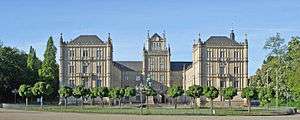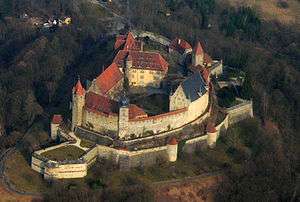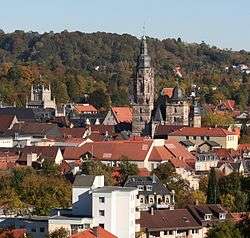Coburg
| Coburg | ||
|---|---|---|
|
View over Coburg | ||
| ||
 Coburg | ||
| Coordinates: 50°16′N 10°58′E / 50.267°N 10.967°ECoordinates: 50°16′N 10°58′E / 50.267°N 10.967°E | ||
| Country | Germany | |
| State | Bavaria | |
| Admin. region | Oberfranken | |
| District | Urban district | |
| Government | ||
| • Lord Mayor | Norbert Tessmer (SPD) | |
| Area | ||
| • Total | 48.30 km2 (18.65 sq mi) | |
| Population (2013-12-31)[1] | ||
| • Total | 40,994 | |
| • Density | 850/km2 (2,200/sq mi) | |
| Time zone | CET/CEST (UTC+1/+2) | |
| Postal codes | 96450 | |
| Dialling codes | 09561 | |
| Vehicle registration | CO | |
| Website | www.coburg.de | |
Coburg is a town located on the Itz River in Bavaria, Germany. Its 2005 population was 42,015. Long one of the Thuringian states of the Wettin line, it joined with Bavaria by popular vote in 1920. Before 1918, it was one of the capital cities in the duchy of Saxe-Coburg and Gotha and the duchy of Saxe-Coburg-Saalfeld.
Coburg's coat of arms, honoring the city's patron Saint Maurice, was granted in 1493.
Geography
Location
Coburg lies about 90 km south of Erfurt and about 100 km north of Nuremberg.
Subdivisions
Coburg is divided into 15 districts:

- Coburg City
- Beiersdorf
- Bertelsdorf
- Cortendorf
- Creidlitz
- Glend
- Ketschendorf
- Löbelstein
- Lützelbuch
- Neu- and Neershof
- Neuses
- Rögen
- Scheuerfeld
- Seidmansdorf
- Wüstenahorn
History


Coburg was first mentioned in a document dated 1056, although there was a settlement at the site that predates it called Trufalistat. Following several changes of feudal ownership, it came into the hands of the House of Wettin in 1353 from the House of Henneberg with the marriage of Friedrich III, the Strong, with Katherina von Henneberg and was initially regarded by them as a Saxon outpost within Franconia.
In 1596, it was raised to the status of capital of one of the dynasty's splintered Saxon-Thuringian territories, the new Duchy of Saxe-Coburg under the leadership of Duke Johann Casimir (ruled 1596–1633). From 1699 to 1826, it was one of the two capitals of the Duchy of Saxe-Coburg-Saalfeld, and from 1826-1918 it was a capital of the Duchy of Saxe-Coburg-Gotha.
One of Germany's largest castles, the mighty Veste Coburg citadel, built starting in 1225 (upon the site of an 11th-century chapel), dominates the town from its hilltop. During the Diet of Augsburg in 1530 reformer Martin Luther spent six months at the castle (located at the southernmost point of the Saxon duchy) while his liege lord, the Duke of Saxony, attended the Diet. Luther was forbidden to attend by the duke, who feared that he would be imprisoned and burned as a heretic. While quartered at the castle Luther continued with his translation of the Bible into German.
In the old town at the base of the castle hill, the Ehrenburg Palace (a former Franciscan Monastery) was rebuilt in 1543. It was gutted by fire in 1690 and rebuilt in a Baroque style, with stucco work by North Italian craftsmen that includes a famous "Hall of the Giants" (which contains a plaque that states it was the location of the first meeting between Britain's Queen Victoria and Franz Josef Emperor of Austria in 1860).
Ernst Frederick, the fourth Duke of Saxe-Coburg-Saalfeld, moved his capital from Saalfeld to Coburg in 1764. Coburg then became capital of the Duchy of Saxe-Coburg-Saalfeld and then the Duchy of Saxe-Coburg and Gotha. During the 19th century, dynastic marriages created ties with the royal families of Belgium, Bulgaria, Portugal and Britain. The era of political dominance peaked with Leopold Friedrich; born Prince of Saxe-Coburg-Saalfeld, becoming the King of Belgians in 1831 and Prince Albert of Saxe-Coburg and Gotha, born in Schloss Rosenau, marrying his first cousin, Queen Victoria in 1840. The marriage between Albert and Victoria established the present British royal house, which renamed itself Windsor during World War I. This marriage in turn led to a union with Germany's ruling dynasty, the Hohenzollerns, when the couple's eldest child, Victoria, married the future Kaiser Friedrich III.
After her marriage, Queen Victoria said of Coburg:
If I were not who I am, this would have been my real home, but I shall always consider it my second one.[2]
Due to the royal connections among the royal houses of Europe, Coburg was the site of many royal Ducal weddings and visits. Britain's Queen Victoria made six visits to Coburg during her 63-year reign. In 1894 one ceremony brought together Queen Victoria, her son Edward (future Edward VII), her second son Alfred (Duke of Saxe-Coburg-Gotha), her daughter the German dowager Empress Friedrich (Victoria), and many of her grandchildren, such as future Tsar Nicholas and Alexandra of Russia, Kaiser Wilhelm II of Germany, and the future King George V of Britain.



In 1920, two years after the abdication of the last duke, the locals voted to join Bavaria. Thus whilst the other Saxon-Thuringian principalities were later incorporated into the German Democratic Republic after World War II, Coburg became part of West Germany. As a result, the town spent the Cold War years lying right next to the Iron Curtain, surrounded by East German territory on three sides.
In 1929, Coburg was the first German city in which the Nazi Party won the absolute majority of the popular vote during municipal elections.[3]
In 1946, Polish ambassador Oskar R. Lange alleged that Coburg was a base for the Western Allies to organize a Polish armed insurgency led by Władysław Anders against Soviet-backed communists in Poland.[4]
Demographics
Over two thirds of Coburg's population live in Coburg City.
Religion
Most residents of Coburg are members of the Evangelical Church (Lutheran). Other Christian communities are Baptists, Seventh-day Adventists, the ICF Movement, Jehovah's Witnesses, Catholics, Old Catholics and the New Apostolic Church, as well as The Church of Jesus Christ of Latter-day Saints. There are also three communities of Muslims. Coburg had a large Jewish community until the 1940s. Jews had lived there since the 14th century. The old synagogue was a former church. Today it is used by Old Catholics. Coburg became Protestant after the Reformation. All Catholics were persecuted. A new Catholic community was founded in the 19th century.
Government
Town twinning
Coburg is twinned with:
 Cobourg, Ontario, Canada
Cobourg, Ontario, Canada Gais, South Tyrol
Gais, South Tyrol Garden City, New York, USA
Garden City, New York, USA Isle of Wight, United Kingdom
Isle of Wight, United Kingdom Niort, France
Niort, France.svg.png) Oudenaarde, Belgium
Oudenaarde, Belgium
Attractions
Coburg has the typical features of a former capital of a German princely state. There are numerous houses from the 16th, 17th and 18th centuries. The most important landmarks include:
- Ehrenburg, a former Franciscan convent built in 1220 and turned into a castle in 1543–1549, and renovated until the 19th century. The internal decoration dates from the late 17th to early 18th centuries. Its Gothic Revival exterior was remodelled by Karl Friedrich Schinkel in the 19th century. It now also houses a museum as well as a famous library.
- St.-Moriz Church ("St. Maurice", 14th-16th centuries), is a Gothic edifice on the Hallenkirche plan with two towers. The interior, remade in 1701, include the notable funerary moment of Duke John Casimir, a 12 m-tall alabaster sculpture painted with statue and reliefs (1595–1598).
- The medieval Veste Coburg, one of the biggest castles in Germany. It was mostly rebuilt in the 19th century. It has a triple line of walls with numerous towers. Today the Veste Coburg is home to three museums. One is the Ducal Palace (Fürstenbau), with many furnished rooms of the Dukes of Coburg, including the apartment where Martin Luther lived in 1530. Probably the most notable room in the castle (unique in all of Germany) is the Hunting Room (Jagdzimmer) of 1632, which is entirely made of marquetry wood inlay, done up with over 60 marquetry panels, deeply coffered marquetry ceilings and a wood paneled floor. Another museum is the Armory (Rüstkammer), containing the largest collection of medieval armour and weaponry in Germany, with over 10,500 items. The third is the Art Collections (Kunstsammlungen), which contains a world class collection of 300,000 engravings (Kupferstich-Kabinett), a 20,000 piece coin collection (Münzkabinett), a 7000 piece documentation collection (Briefe & Urkunden), and a 3,500 piece glassware collection (Gläser-Sammlung).
- Gymnasium Casimirianum, a Renaissance building begun in 1601.
- Arsenal (1616–1621)
- Coburg State Theater
- Coburg Doll Museum
- Town Hall (1414)
- Rose Garden
- Callenberg Castle, with Saxe-Coburg family art collection and National Shooting Museum
- Castle Rosenau near Coburg
- St. Augustin, opened in 1860.
- The Baroque Basilica of the Vierzehnheiligen, 20 km outside the city.
Arts and culture
Coburg is home to two major festivals: Samba-Festival Coburg and Johann Strauss Musiktage. Coburg is referred to as "Europe's Capital of Samba."[5]
As a result of the large presence of the US Army prior to German re-unification, Americans and American culture are still present in Coburg and the surrounding area. This influence ranges from American-style pubs and restaurants to two sports clubs sponsoring[6] baseball teams.
Trivia
The National Hot Dog and Sausage Council asserts that Frankfurt is traditionally credited with originating the frankfurter. According to the Council, this claim is disputed and that the hot dog was created in the late 17th century by Johann Georghehner, a butcher, living in Coburg.[7]
Coburg was the first German town to elect a Nazi Mayor.
A popular local delicacy is the Coburger Bratwurst, a sausage (the official size of which is denoted by the a Marshall's staff hold by the statue of the city's patron, Sankt Mauritius, located on the town hall and overlooking the square) roasted over a pine cone fire. The sausage is served in a Semmel (a small bread bun, a third the size of the sausage itself), and is highly popular with locals and tourists alike.
Coburg Peak on Trinity Peninsula in Graham Land, Antarctica is named after the town, in connection with the Bulgarian royal house of Coburg (Saxe-Coburg-Gotha).[8]
Infrastructure
Transport
Car
Coburg can be reached by car via B 303 Schweinfurt-Coburg-Schirnding, B 4 Hamburg-Coburg-Nürnberg or motorway A 73 Suhl-Coburg-Nürnberg.
Railways
Coburg has four train stations:
- Coburg-Neuses
- Coburg-Nord
- Coburg main station
- Coburg-Creidlitz
From the main station one can go to Lichtenfels, Bamberg, Forchheim, Erlangen, Fürth and Nürnberg, to Neustadt bei Coburg, Sonneberg, to Bad Rodach and to Kulmbach, Neuenmarkt-Wirsberg.
In the future, some Intercity-Express high speed trains will stop in Coburg on the Nuremberg–Erfurt high-speed railway, part of a new Berlin-Erfurt-Coburg-Nürnberg route.
Airports
Small planes can land on the two airfields:
- Coburg Brandensteinsebene (ICAO-Code: EDQC, founded in 1912)
- Coburg Steinrücken (ICAO-Code: EDQY)
Large airports nearby are in Frankfurt, Erfurt and Nuremberg.
Local public transport system
The public transport system in Coburg is operated by SÜC (Stadt- und Überlandwerke Coburg) with 22 bus lines. The OVF (Omnibus Verkehr Franken) covers Coburg's surrounding countryside with an additional 11 bus lines.
Notable people
Besides various royalty, other famous individuals associated with Coburg include Hans Berger (graduated), William Frishmuth (born), and Eduard Study (born).
- In 1530, Martin Luther stayed in the Veste Coburg to follow negotiations at the Imperial Diet in Augsburg. He also preached at St. Moriz church.[9]
- In 1887, Johann Strauss, better known as the Waltz King, left Vienna when the Roman Catholic Church forbade his divorce from his second wife. So he moved to Lutheran Saxe-Coburg-Gotha with his future third wife Adele, where he lived the last 13 years of his life in Coburg. He was however buried in Vienna.
- In 1922, Adolf Hitler led several hundred stormtroopers in a march through the city, fighting pitched street battles with leftists and communists. During the Nazi era, the Coburg Badge (made to honor the participants) was one of the most prestigious party medals.
- Hans Morgenthau, founder of International Relations as a field of study, was born here.
- Fritz Mollwitz, professional baseball player, was born here.
- Baroness Louise Lehzen, governess and adviser to Queen Victoria, lived here.
- Prince Albert, husband of Queen Victoria, was born in Schloss Rosenau, Coburg.
References
- ↑ "Fortschreibung des Bevölkerungsstandes". Bayerisches Landesamt für Statistik und Datenverarbeitung (in German). 31 December 2013.
- ↑ David Duff, Victoria and Albert (1972), p. 9
- ↑ Man of the Year, TIME Magazine, January 2, 1939
- ↑ The Milwaukee Journal - Google News Archive Search
- ↑ DAAD - Studieren in Deutschland
- ↑ http://www.sgroedental.de/Baseball
- ↑ National Hot Dog & Sausage Council
- ↑ Coburg Peak. SCAR Composite Gazetteer of Antarctica.
- ↑ Heavenly International Tours - Lutherland Tour of Germany
External links
| Wikimedia Commons has media related to Coburg. |
| Wikivoyage has a travel guide for Coburg. |
- Coburg Tourist Board
- World sites atlas
- Schloss- under Gartenverwaltung Coburg
- Sister Cities of Coburg
|

